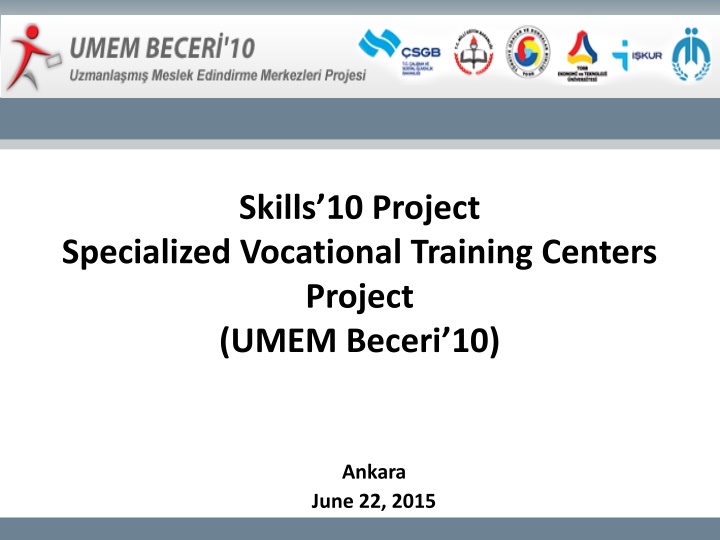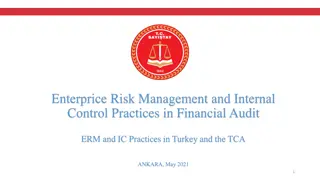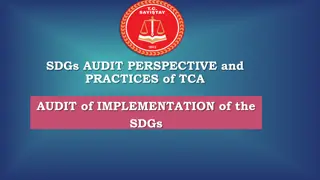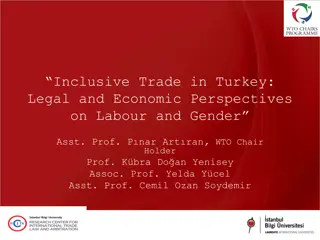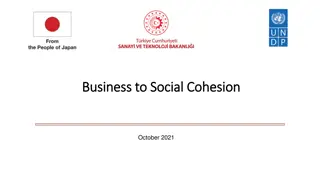Skills Development for Economic Growth in Turkey
This project focuses on addressing the challenge of an unskilled workforce in Turkey through specialized vocational training centers. By improving the vocational education system, it aims to enhance human capital, reduce skills mismatches, boost competitiveness, lower unemployment rates, and foster economic growth. The private sector plays a crucial role in bridging the gap between job seekers and employers, thereby contributing to the country's economic development.
Download Presentation

Please find below an Image/Link to download the presentation.
The content on the website is provided AS IS for your information and personal use only. It may not be sold, licensed, or shared on other websites without obtaining consent from the author.If you encounter any issues during the download, it is possible that the publisher has removed the file from their server.
You are allowed to download the files provided on this website for personal or commercial use, subject to the condition that they are used lawfully. All files are the property of their respective owners.
The content on the website is provided AS IS for your information and personal use only. It may not be sold, licensed, or shared on other websites without obtaining consent from the author.
E N D
Presentation Transcript
Skills10 Project Specialized Vocational Training Centers Project (UMEM Beceri 10) Ankara June 22, 2015
Framework Skills development for economic development Unskilled workforce as a major problem in Turkey Important role for the private sector UMEM Skills 10 Project Conclusions
Skills Development Skills development for economic development Unskilled workforce as a major problem in Turkey Important role for the private sector UMEM Skills 10 Project Conclusions
Skills Development Improvement of the vocational education system: improves human capital and productivity reduces skills mismatches in the labor market increases competitiveness of the economy reduces unemployment and poverty promotes economic growth
Unskilled Workforce in Turkey Skills development for economic development Unskilled workforce as a major problem in Turkey Important role for the private sector UMEM Skills 10 Project Conclusions
Unskilled Workforce in Turkey 3,4 million unemployed people in December 2008 (14 % of the workforce) Skills mismatch due to low-skilled work force One of the main reasons behind unemployment Firms have difficulties in hiring qualified staff The global financial crisis exacerbated the situation Mostly unskilled people lost their jobs
Role of the Private Sector Skills development for economic development Unskilled workforce as a major problem in Turkey Important role for the private sector UMEM Skills 10 Project Conclusions
Role of the Private Sector Two sides of the unemployment problem Unemployed people do not satisfy the requirements of firms, due to their low skills. Although there are vacancies, firms can not find qualified candidates in the labor market. The private sector organizations can contribute to reduce these mismatches Taking an active role in the vocational training system Serving as a mediator between firms and job seekers
UMEM Skills10 Skills development for economic development Unskilled workforce as a major problem in Turkey Important role for the private sector UMEM Skills 10 Project Conclusions
UMEM Skills10 Why Skills 10 is Different? A unique example of Public-Private-University Partnership Ministry of National Education Ministry of Labour and Social Security KUR National Employment Agency TOBB TOBB University of Economics and Technology
UMEM Skills10 Why Skills 10 is Different? Local Labor Market Analyses are being conducted for the first time in Turkey Face to face surveys; 8000 companies In the new design, private sector is located at the center of the Vocational Training system through the Chambers of Industry and Commerce Courses for the unemployed are designed according to the requirements of the private sector, to increase their employment opportunities.
UMEM Skills10 Flexible Project Firms get involved in the creation of the course curriculum Firms can choose the trainees they want to employ Firms own foremen can act as trainers in the courses Firms can observe trainees during the whole process Firms can provide in-house trainings
UMEM Skills10 UMEM Skills 10 Activities Strengthening the Infrastructure Renewal of the equipment, Revision of the curricula, Training of the trainers Labor Market Needs Analysis 20 cities selected as pilot, Capacity building for the remaining cities Matching the trainees with the firms Selection of the trainees, Matching the trainees with the firms Implementation of the courses Internships provided for successful trainees, Job placement for successful interns
UMEM Skills10 Process Demand for skilled labor Supply of skilled labor (applicants for training courses) Matching trainees and firms Theoretical and Practical Training Job Placement
UMEM Skills10 Process in Detail Course identification according to the demands and curriculum revision Course announcements and application collection Determination of the trainees according to the interviews Initialization of the courses - Evaluation of the courses Initialization of the internships - (in the factories full time) Evaluation of the internships (will be evaluated by the employer) Employment of the Successful Trainees
UMEM Skills10 Achievements-1 In all 81 cities, 100 million TL (app. 57 million USD*) is invested on the infrastructure of schools. Local Course Management councils were established The instructors of these schools have been trained to train the unemployed. In 20 provinces that constitute 80 % of the work force, Labor Market Needs Analyses are performed. 8.200 firms are surveyed, their requirements concerning their employees and vacant positions are detected. 140 vocational high *Expenditure is converted into dollars using the average annual exchange rate for 2011 which is published by CBRT
UMEM Skills10 Achievements-2 In 8.200 firms, the demand for intern positions are also identified. Analysis results were shared with public by meetings in 20 provinces. Problems of labor market were discussed with industrial employers of 20 provinces. Central Information System studies have been completed. The labor demands can be collected (www.beceri.org.tr) Advertisement activities (posters, brochures, TV programmes, etc.) A 7/24 call center was established in order to respond to informational inquiries. through this system. Result: Successful trainees are getting their certificates.
UMEM Skills10 New Governance Mechanism Course management structure: Empowering local stakeholders Retrieving the labor market information Deciding the courses to be opened Modifying curricula according to local needs Selecting suitable candidates for the courses Quality assurance for the courses Matching local unemployed with local firms Forcing them to work together Local MoNE representative Local KUR representative Local Chamber representative
UMEM Skills10 Current Situation As of 31.12.2014; 6.750 courses and 10.400 intenship programs have been opened for 170 thousand trainees. At the moment 8.810 people are being trained. The successful people are being employed. 7.762 firms have demanded 110 thousand interns so far. More than 100 thousand employed people. Source: Skills 10 Administration System
UMEM Skills10 Profile of the Course Participants 35-44 11% 45+ 1% Female 19% Aged 16-24 49% Aged 25-34 39% Male 81% Higher Education 12% Primary Education 47% Secondary Education 41% Source: Skills 10 Administration System
Conclusions Skills development for economic development Unskilled workforce as a major problem in Turkey Important role for the private sector UMEM Skills 10 Project Conclusions
Conclusions Skills development is essential for economic development Skills development can be seen as a next step for Millennium Development Goals Improving human capital beyond primary education Creating equal opportunity for men and women Private sector should have a key role in the skills development process Skills 10 Project seems as a successful start for Public- Private Sector Partnership (PPP) in vocational education and training Empowering local stakeholders, while forcing them to work together is a key success factor
